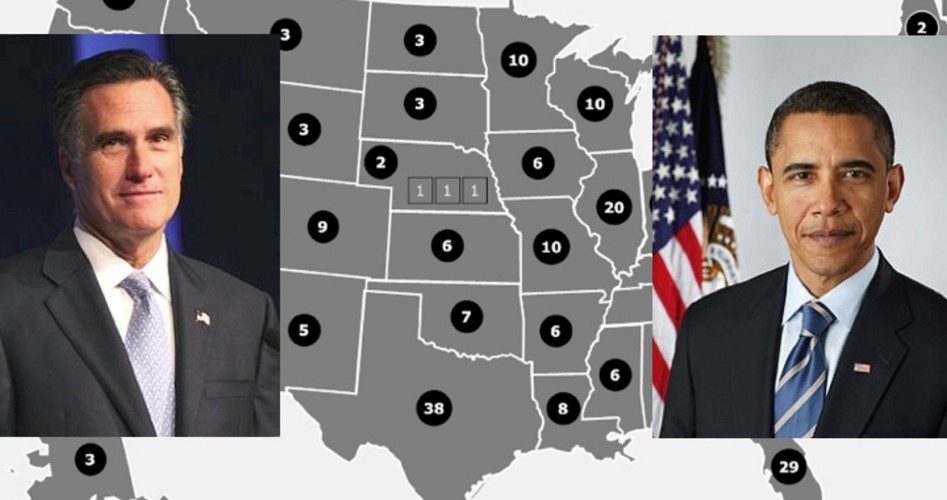
The forecast of the 2012 presidential election by Michael Berry and Kenneth Bicker, political science professors at the University of Colorado, that was released in August has been updated with more current economic information, and the result is the same: a Romney win as the economy continues to falter.
It takes 270 Electoral College votes to win the presidency, and Berry and Bicker are projecting that Governor Mitt Romney will win 330 of the 538 votes up for grabs in November, while President Obama will receive just 208, down from the 213 they predicted in August.
It’s the economy. The model developed by the two professors has an uncanny track record, correctly predicting each presidential election since 1980, often with startling accuracy. In their paper originally published in August by the American Political Science Association [APSA] along with 12 other studies, it differed in its predictive “model” by looking at two essential pieces of the economic puzzle: changes in real per capita income — that is, net, after-tax, spendable income — and unemployment rates. But their model doesn’t just rely on the national numbers provided by the Bureau of Labor Statistics, which has been heavily criticized recently for its inexplicable drop in the unemployment rate while real jobs in the economy aren’t even reaching maintenance levels. It relies also on state-by-state analyses of those same factors, which appear to be more reliable. As the professors note:
In contrast to these other Electoral College models [published by the APSA], our model includes measures of change in real per capita income, as well as national and state unemployment figures.
Accounting for both changes in personal income and unemployment provides a more robust approximation of state economic well-being and, thus, serves to model the impact of retrospective evaluations of the incumbent party’s stewardship of the economy…
The data incorporated in our model are regularly released by the Bureau of Economic Analysis (BEA) in the US Department of Commerce and the Bureau of Labor Statistics in the US Department of Labor. This gives us high-quality, predictably available data to use as the feedstock for our model.
This is how politically correct political science professors cover themselves: just in case the national data get a little dicey, the numbers from the states are more predictive:
The heart of our forecast centers on the third set of independent variables. We use two basic measures of economic conditions: unemployment levels and change in real income per capita. Unemployment is measured in two capacities. First is the national unemployment rate. The second is the corresponding unemployment rate in each state…
Our third measure of economic well-being taps the extent to which people have more or less real disposable income at their discretion during the current incumbent’s presidential term. The measure included in our model is the percentage change in each state in real per capita non-farm income from the fourth quarter of the prior presidential election year to the first quarter of the current election year.
The unstated but important underlying assumption by the professors is almost an iron law of politics: People will vote their pocketbooks. People are hurting, and that’s hurting Obama:
Putting these pieces together, clearly President Obama is in electoral trouble. To be sure, he enjoys some advantages. First, Obama’s successful campaign in 2008 gives him a substantial leg up. He can lose some states that he carried four years ago without losing the election. Second, a prominent second-term incumbency advantage should prove advantageous. Still, the big issue is the fragile economy. With an unemployment rate in excess of 8%, Obama is about two-and-a-half points beyond the break-even point for a Democrat running as the in-party candidate…
The states we predict President Obama will carry include a substantially reduced set than those he carried in 2008. This is supported by the fact that no states won by McCain are predicted to flip to Obama.
What is striking about our state-level economic indicator forecast is the expectation that Obama will lose almost all of the states currently considered as swing states, including North Carolina, Virginia, New Hampshire, Colorado, Wisconsin, Minnesota, Pennsylvania, Ohio, and Florida. Three other states that might be viewed as swing states — Michigan, New Mexico, and Nevada — are predicted to stay in Obama’s column. Our forecast is that the president will receive 208 Electoral College votes, putting him well short of the 270 needed to win reelection.
The economy is having an impact on other presidential predictions, moving the election towards Romney as well. USA Today said on Sunday that Obama’s perceived lead in Electoral College votes, 265 to 191 for Romney, as recently as two weeks ago has now dropped precipitously to just 201 to 191 currently, with 11 states considered to be “toss-ups” with 146 votes at stake there.
Scott Rasmussen noted that as of Monday, “Romney has had a slight lead or been tied on nine of the past 10 days. Before that, Obama had been ahead or tied for 16 consecutive days.” Rasmussen is still calling it a close race, but “in a close race, even a small change can have a big impact.”
Intrade, the online betting site, has also seen a precipitous drop in support for Obama, moving from an apparently invincible high approaching 80 percent to just over 60 percent as of this writing.
If the college professors are right, and voters vote their pocketbooks, and the data they are using to make their predictions are anywhere close to being accurate, Romney should win in November. As the economy continues its decline, so do Obama’s chances at reelection. Perhaps that’s why he’s looking at buying a retirement mansion in Hawaii.

